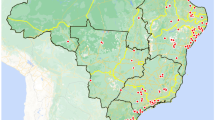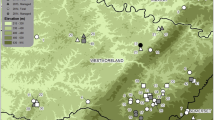Abstract
Varroa mites are ecto-parasites of honeybees and are a threat to the beekeeping industry. We identified the haplotype of Varroa mites and evaluated potential factors that influence their prevalence and infestation levels in the eastern and western highland agro-ecological zones of Uganda. This was done by collecting samples of adult worker bees between December 2014 and September 2015 in two sampling moments. Samples of bees were screened for Varroa using the ethanol wash method and the mites were identified by molecular techniques. All DNA sequences obtained from sampled mite populations in the two zones were 100 % identical to the Korean Haplotype (AF106899). Mean mite prevalence in the apiaries was 40 and 53 % for the western and eastern zones, respectively, during the first sampling. Over the second sampling, mean mite prevalence increased considerably in the western (59 %) but not in the eastern (51 %) zone. Factors that were associated with Varroa mite infestation levels include altitude, nature of apiary slope and apiary management practices during the first sampling. Our results further showed that Varroa mites were spreading from lower to higher elevations. Feral colonies were also infested with Varroa mites at infestation levels not significantly different from those in managed colonies. Colony productivity and strength were not correlated to mite infestation levels. We recommend a long-term Varroa mite monitoring strategy in areas of varying landscape and land use factors for a clear understanding of possible changes in mite infestation levels among African honeybees for informed decision making.

Similar content being viewed by others
References
Akinwande K, Badejo M, Ogbogu S (2012) Incidence of the Korean haplotype of Varroa destructor in southwest Nigeria. J Apicult Res 51(4):369–370
Anderson D, Trueman JW (2000) Varroa jacobsoni (Acari: Varroidae) is more than one species. Exp Appl Acarol 24(3):165–189
Beetsma J (1994) The Varroa mite, a devastating parasite of western honeybees and an economic threat to beekeeping. Outlook Agr 23:169–175
Bowen-Walker PL, Martin SJ, Gunn A (1999) The transmission of deformed wing virus between honeybees (Apis mellifera L.) by the ectoparasitic mite Varroa jacobsoni Oud. J Invertebr Pathol 73:101–106
Buchler R, Berg S, Le Conte Y (2010) Breeding for resistance to Varroa destructor in Europe. Apidologie 41:393–408
Calderón RA, van Veen JW, Sommeijer MJ, Sanchez LA (2010) Reproductive biology of Varroa destructor in Africanized honey bees (Apis mellifera). Exp Appl Acarol 50(4):281–297
Cornman RS, Tarpy DR, Chen Y, Jeffreys L, Lopez D, Pettis JS, Evans JD (2012) Pathogen webs in collapsing honey bee colonies. PLoS One 7(8):1–15
Dainat B, Evans JD, Chen YP, Gauthier L, Neumann P (2012) Dead or alive: deformed wing virus and Varroa destructor reduce the life span of winter honeybees. Appl Environ Microbiol 78(4):981–987
Dietemann V, Pirk CWW, Crewe R (2009) Is there a need for conservation of honeybees in Africa? Apidologie 40(3):285–295
Dietemann V, Nazzi F, Martin SJ, Anderson DL, Locke B, Delaplane KS, Ellis JD (2013) Standard methods for Varroa research. J Apicult Res 52(1):1–54
Emsen B, Petukhova T, Guzman-Novoa E (2012) Factors limiting the growth of Varroa destructor populations in selected honeybee (Apis mellifera L.) colonies. J Anim Vet Adv 11(24):4519–4525
Evans J, Lopez D (2002) Complete mitochondrial DNA sequence of the important honey bee pest, Varroa destructor (Acari: Varroidae). Exp Appl Acarol 27:69–78
Fazier M, Muli E, Conklin T, Schmehl D, Torto B, Frazier J, Raina S (2010) A scientific note on Varroa destructor found in East Africa; threat or opportunity? Apidologie 41:463–465
Fletcher D, Mackenzie D, Villouta E (2005) Modelling skewed data with many zeros: a simple approach combining ordinary and logistic regression. Environ Ecol Stat 12:45–54
Gern L, Cadenas FM, Burri C (2008) Influence of some climatic factors on Ixodes ricinus ticks studied along altitudinal gradients in two geographic regions in Switzerland. Int J Med Microbiol 298:55–59
Ghazoul J (2005) Buzziness as usual? Questioning the global pollination crisis. Trends Ecol Evol 20(7):367–373
Jacobs FJ, Simoens C, DeGraaf DC, Deckers J (2006) Scope for non-wood forest products income generation from rehabilitation areas: focus on beekeeping. J Drylands 1(2):171–185
Kajobe R, Agea JG, Kugonza DR, Alioni V, Otim SA, Rureba T (2009) National beekeeping calendar, honeybee pest and disease control methods for improved production of honey and other hive products in Uganda. National Agricultural Research Organization, Entebbe
Kajobe R, Marris G, Budge G, Laurenson L, Cordoni G, Jones B, Brown M (2011) First molecular detection of a viral pathogen in Ugandan honey bees. J Invertebr Pathol 104(2):153–156
Le Conte Y, Ellis M, Ritter W (2010) Varroa mites and honey bee health: can Varroa explain part of the colony losses ? Apidologie 41:353–363
Martin SJ (2001) The role of Varroa and viral pathogens in the collapse of honeybee colonies: a modelling approach. J Appl Ecol 38:1082–1093
Martin SJ, Medina LM (2004) Africanized honeybees have unique tolerance to Varroa mites. Trends Parasitol 20(3):112–114
Meixner MD, Francis RM, Gajda A, Kryger P, Andonov S, Uzunov A, Wilde J (2014) Occurrence of parasites and pathogens in honey bee colonies used in a European genotype-environment interactions experiment. J Apicult Res 53(2):215–219
Melin A, Rouget M, Midgley JJ, Donaldson JS (2014) Pollination ecosystem services in South African agricultural systems. S Afr J Sci 110(11):1–9
Moretto G, Leonidas JD (2003) Infestation and distribution of the mite Varroa destructor in colonies of Africanized bees. Braz J Biol 63(1):83–86
Moritz RF, de Miranda J, Fries I, Le Conte Y, Neumann P, Paxton R (2010) Research strategies to improve honeybee health in Europe. Apidologie 41:227–242
Muli E, Patch H, Frazier M, Frazier J, Torto B, Baumgarten T, Grozinger C (2014) Evaluation of the distribution and impacts of parasites, pathogens, and pesticides on honey bee (Apis mellifera) populations in East Africa. PLoS One 9(4):1–11
Mumbi CT, Mwakatobe AR, Mpinga IH, Richard A, Machumu R (2014) Parasitic mite, Varroa species (Parasitiformes : Varroidae) infesting the colonies of African honeybees, Apis mellifera scutellata (Hymenoptera : Apididae) in Tanzania. J Entomol Zool Stud 2(3):188–196
Navajas M, Anderson DL, de Guzman LI, Huang ZY, Clement J, Zhou T, Le Conte Y (2010) New Asian types of Varroa destructor: a potential new threat for world apiculture. Apidologie 41:181–193
NEMA (2009) Uganda Atlas of our changing environment. National Environment Management Authority (NEMA) NEMA House, Kampala, Uganda, Kampala
Nguyen BK, Ribière M, VanEngelsdorp D, Snoeck C, Saegerman C, Kalkstein AL, Haubruge E (2011) Effects of honey bee virus prevalence, Varroa destructor load and queen condition on honey bee colony survival over the winter in Belgium. J Apicult Res 50(3):195–202
Paxton RJ (2010) Does infection by Nosema ceranae cause “Colony Collapse Disorder” in honey bees (Apis mellifera)? J Apicult Res 49(1):80–84
Pirk CW, Strauss U, Yusuf AA, Demares F (2015) Honeybee health in Africa—a review. Apidologie. doi:10.1007/s13592-015-0406-6
Rasolofoarivao H, Clemencet J, Ravaomanarivo LH, Razafindrazaka D, Reynaud B, Delatte H (2013) Spread and strain determination of Varroa destructor (Acari: Varroidae) in Madagascar since its first report in 2010. Exp Appl Acarol 60:521–530
Rinderer TE, Harris JW, Hunt GJ, de Guzman LI (2010) Breeding for resistance to Varroa destructor in North America. Apidologie 41:409–424
Rosenkranz P (1999) Honey bee (Apis mellifera L.) tolerance to Varroa jacobsoni Oud. in South America. Apidologie 30:159–172
Rosenkranz P, Aumeier P, Ziegelmann B (2010) Biology and control of Varroa destructor. J Invertebr Pathol 103:S96–S119
Ruíz-Flores A, Ramírez-Hernández E, Maldonado-Simán E, Palafox-Guillén J, Ochoa-Torres E, López-Ordaz R (2012) Incidence and infestation level of varroatosis in honeybees (Apis mellifera) at the bee identification and diagnosis laboratory from 2002–2006. Rev Chapingo Ser Cie 18(2):175–182
Shen M, Yang X, Cox-foster D, Cui L (2005) The role of Varroa mites in infections of Kashmir bee virus (KBV) and deformed wing virus (DWV) in honey bees. Virology 342:141–149
Solignac M, Cornuet JM, Vautrin D, Le Conte Y, Anderson D, Evans J, Navajas M (2005) The invasive Korea and Japan types of Varroa destructor, ectoparasitic mites of the Western honeybee (Apis mellifera), are two partly isolated clones. Proc R Soc B 272:411–419
Spiewok S, Pettis JS, Duncan M, Spooner-Hart R, Westervelt D, Neumann P (2007) Small hive beetle, Aethina tumida, populations I: infestation levels of honeybee colonies, apiaries and regions. Apidologie 38:595–605
Strauss U, Human H, Gauthier L, Crewe RM, Dietemann V, Pirk CWW (2013) Seasonal prevalence of pathogens and parasites in the savannah honeybee (Apis mellifera scutellata). J Invertebr Pathol 114:45–52
Strauss U, Pirk CW, Dietemann V, Crewe R, Human H (2014) Infestation rates of Varroa destructor and Braula coeca in the savannah honey bee (Apis mellifera scutellata). J Apicult Res 53(4):475–477
Strauss U, Pirk CWW, Crewe RM, Human H, Dietemann V (2015) Impact of Varroa destructor on honeybee (Apis mellifera scutellata) colony development in South Africa. Exp Appl Acarol 65:89–106
Van Dooremalen C, Stam E, Gerritsen L, Cornelissen B, VanderSteen J, VanLangevelde F, Blacquiere T (2013) Interactive effect of reduced pollen availability and Varroa destructor infestation limits growth and protein content of young honey bees. J Insect Physiol 59(4):487–493
Acknowledgments
We thank beekeepers whose apiaries were sampled for their cooperation and the Ministry of Agriculture, Animal Industry and Fisheries, Uganda for the support rendered. The Uganda National Council for Science and Technology granted research permission for which we are grateful. We further greatly thank I. Mayegu, S. Cherotich, N. Erikibankya, A. Thabulenga and A. Bagonza for the assistance during fieldwork. Two anonymous reviewers provided useful comments which we appreciate. The Caribu project under Erasmus Mundus Action 2 scholarship to Moses Chemurot is also greatly appreciated.
Author information
Authors and Affiliations
Corresponding author
Rights and permissions
About this article
Cite this article
Chemurot, M., Akol, A.M., Masembe, C. et al. Factors influencing the prevalence and infestation levels of Varroa destructor in honeybee colonies in two highland agro-ecological zones of Uganda. Exp Appl Acarol 68, 497–508 (2016). https://doi.org/10.1007/s10493-016-0013-x
Received:
Accepted:
Published:
Issue Date:
DOI: https://doi.org/10.1007/s10493-016-0013-x




